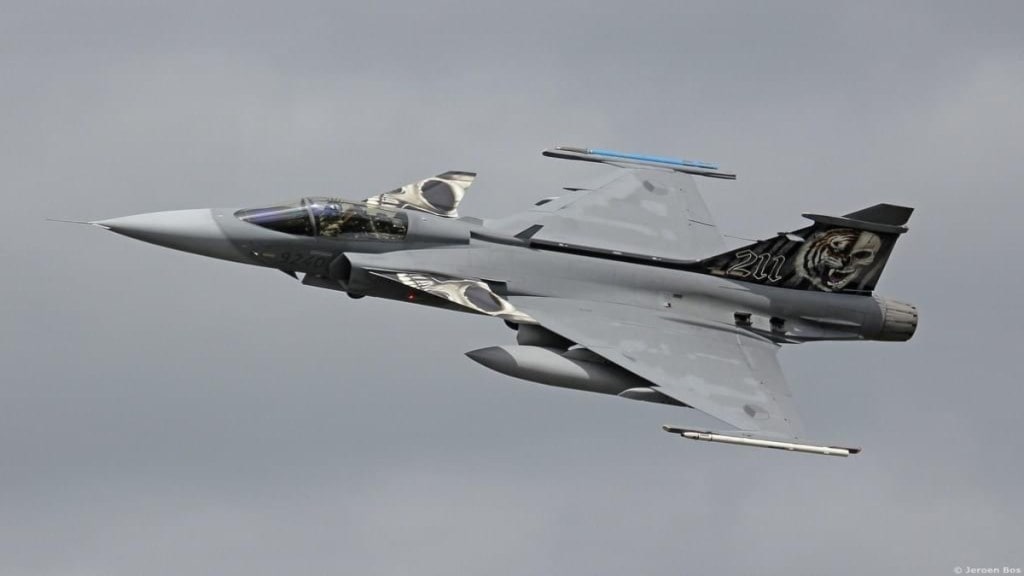As India advances toward the procurement of 114 Multi-Role Fighter Aircraft (MRFA) for the Indian Air Force (IAF), Sweden’s SAAB has thrown its hat into the ring, making a compelling case for its Gripen jets. SAAB’s ambition is to establish a comprehensive ecosystem in India, promising not just advanced technology but also a significant transfer of knowledge and manufacturing capabilities. However, despite its promises, the Gripen faces stiff competition and scrutiny, particularly in light of India’s push for indigenous defense manufacturing under the ‘Aatmanirbhar Bharat’ initiative.
SAAB’s Gripen Jets: Technological Marvels
At the core of SAAB’s offer are the Gripen-E and Gripen-F variants, designed with advanced avionics, powerful engines, and versatile payload capabilities. The Gripen E, powered by the GE FE14G engine, boasts impressive range and a capacity to carry a wide range of weaponry through its ten hardpoints. Kent-Ake Molin, Head of Gripen for India Programme, highlights the aircraft’s advanced technology, stating, “We envisioned Gripen E to be an extension of the pilot’s mind and body, and we achieve it through advanced Human Machine Collaboration (HMC).”
This HMC is a key selling point, with SAAB emphasizing its ability to seamlessly integrate the pilot’s decision-making with the machine’s capabilities. The Gripen-E’s cockpit, redesigned with this concept in mind, incorporates a hands-on-throttle-and-stick (HOTAS) setup, reducing distractions and enhancing situational awareness. The aircraft’s radar and infrared tracking systems are top-notch, and it can carry a versatile mix of armaments, making it suitable for both air-to-air and air-to-ground missions.
Additionally, the fighter jet has undergone extensive upgrades, including a new AESA radar and increased fuel capacity, allowing it to stay airborne longer than previous models. Its integration of Artificial Intelligence (AI) is another factor that sets it apart, providing the pilot with timely, relevant information to execute missions more effectively.
The India Proposition: Local Manufacturing and Technology Transfer
A major part of SAAB’s proposal is the establishment of a production and upgrade ecosystem within India, aligning with the ‘Aatmanirbhar Bharat’ initiative. SAAB already has a successful model in place in Brazil, where it has set up local production and test facilities for the Gripen. According to Molin, SAAB is eager to replicate this success in India. “We have already established a supply chain in India, and we are looking to gear up and see how we can build or establish a supply network for Gripen in India, to be made in India, being part of the Gripen industrial global system and also to export to other nations,” he said.
This approach seems tailor-made for India’s defense goals. By manufacturing the jets locally, SAAB aims to reduce dependency on foreign equipment and bolster India’s defense industry. The company claims it can deliver the first batch of fighter jets within three years if awarded the contract, emphasizing that it has the capability to ramp up production quickly.
However, while SAAB’s plans for local production and technology transfer sound promising, the reality of such deals is often more complex. Building a supply chain in India from scratch and integrating it with SAAB’s global system will require significant investment, time, and coordination. Moreover, SAAB’s success will depend on how effectively it can collaborate with Indian companies, both large and small, to create a sustainable ecosystem.
Potential Drawbacks: Can SAAB Deliver?
While SAAB’s Gripen-E offers cutting-edge technology and a commitment to local production, there are potential drawbacks that cannot be ignored. One of the primary concerns is the extent of SAAB’s reliance on foreign original equipment manufacturers (OEMs) for key components. Many critical parts of the Gripen, including the engine, radar systems, and avionics, are sourced from the US, Britain, and other European nations. This reliance could pose challenges for India’s defense self-reliance goals and expose the country to supply chain risks in the future.
Moreover, SAAB’s proposal must contend with India’s commitment to the Light Combat Aircraft (LCA) Tejas program. The government has been investing heavily in the indigenous Tejas fighter, which has seen significant improvements in recent years. While the Gripen may offer more advanced capabilities, India may be reluctant to fully embrace a foreign jet at the expense of its own defense projects.
Another potential issue is whether SAAB’s ambitious promises will translate into tangible benefits for India. The company’s track record in Brazil is impressive, but the Indian defense landscape presents unique challenges. The integration of advanced technologies like Artificial Intelligence and quantum computing, as promised by SAAB, will require substantial investment in infrastructure and expertise in India. These are areas where the country is still developing, and there is a risk that the technology transfer may not be as seamless or rapid as anticipated.
High Stakes for India’s Air Power
SAAB’s Gripen-E undoubtedly presents a strong contender for India’s MRFA program, offering state-of-the-art technology, local production, and a substantial transfer of knowledge. However, the decision to go with the Gripen involves weighing these advantages against several risks, including dependency on foreign OEMs and the potential impact on India’s indigenous defense projects.
As India moves closer to making a decision, the Gripen’s future in the country will depend not just on its technological prowess, but also on SAAB’s ability to deliver on its promises of local production and technology transfer. For India, the stakes are high, and the Gripen offers both opportunity and risk in equal measure.

